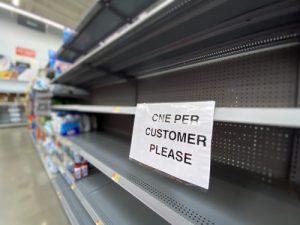‘Bottlenecks on Top of Bottlenecks’
From the garment industry to automotive suppliers, from the exorbitant rise in everything from commercial semiconductors to Thanksgiving dinner, from delays in delivering goods ranging from online gift orders to a new sofa, private citizens and international corporations alike have been at the mercy of disruptions in the supply chain for nearly two years now. And it feels like there’s no end in sight.
It is less of a consequence of the pandemic’s far-reaching disruptions than a perfect storm wreaking havoc on an already precarious flow of consumer goods, raw materials and international commerce. 
In the summer of 2018, nearly a year and a half before the first outbreak of the SARS-CoV-2 novel coronavirus, Harvard Business Review published an article prophetically titled “The Death of the Supply Chain.” It forecast that within five to 10 years, supply chains may no longer sit at the heart of company operations, nudged into obsolescence by digital technologies automating those processes to a point where they require “very little human intervention” to run.
One of the anticipated challenges at the time was fine-tuning, adapting and ultimately streamlining automation to a point where it’s no longer a new development that some workers and industries are getting used to, and, instead, becomes an established practice allowing the flow of international goods, produce, materials and other trade to move along as efficiently as a hands-off process was intended to facilitate.
Of course, no one could predict that COVID would further complicate the international, continental and local flow of goods. The invisible hand of supply-chain management, an afterthought when things are running smoothly and stores aren’t struggling to fill empty spaces on increasingly barren shelves, becomes all too conspicuous when things start—and keep—going wrong.
“It’s taken a long time for this to develop and feed upon itself, and it will take a long time for it to unwind itself,” says Mike Aller.
Aller is director of supplier development for FloridaMakes, a statewide partnership that aims to strengthen and advance Florida’s manufacturing economy by improving its productivity and technology performance. He says that the elements contributing to the current snag in supplies aren’t just pandemic-exacerbated stockpiling behaviors, diminished worker pools and material shortages. It’s also neglected domestic infrastructure, underfunded logistic chains and regulatory changes, all of which predate COVID’s outbreak on U.S. soil.
“I would say it became apparent that there was a significant disruption to global logistics in December 2019 or January 2020—it’s been brewing that long,” says Aller. “You could see it coming a few months before it actually came to roost here. China had to deal with the pandemic before we did, and so much of the global value chain flows through China or touches China at one point.”
But he highlights how long-gestating issues came to fruition when COVID’s unprecedented impact interfered with all the “different dynamics that are overlaid on top of each other” to impact cross-border supply chains.
“Things have been tight for quite a while,” Aller notes. “We knew things were tight before, but there wasn’t the domino of a particular disruption creating knock-down effects to this degree.”
Aller notes that there have been numerous changes to the regulated working hours of those individuals who physically move the supply chain along. The advent of limiting how many hours a day a pilot or long-haul trucker can work revealed how prohibitively understaffed that element of ushering products from one corner of the world to another is.
“Things were stretched before, but there were certain things mitigating that,” he says. “One of them was a lot of overtime hours: Certain drivers would just burn themselves out going as hard as they could. That [overtime] got cut back because new requirements were enforced, which was ultimately a good thing because having drivers go 12 hours a day every single day is not a good idea. But that created a capacity constraint that wasn’t there before.
“When you add some of these newer issues, challenges and disruptions, there’s less slack within the system for us to adjust to those changes,” Aller continues. “It’s sort of like these sequential cancellations in the aircraft and airline industry recently. They’ll have some issue and then there aren’t enough pilots. And the pilots they do have, whether because they’re delayed or because their time in the cockpit gets cut off at eight hours, can’t fly. If they don’t have enough people in the right places with enough time left to fly their planes, they end up canceling hundreds of flights.”
That lack of qualified people or ways to get the job done is a prevailing issue up and down the supply chain, right on down to offloading items from their shipping vessels.
“If you don’t have enough resources in the right places at the right time, then you don’t have an easy way to unload those things with the demand that you’re seeing,” Aller explains. “Then you just get bottlenecks—and we have bottlenecks all over the place now. We have bottlenecks on top of bottlenecks.”
The impulse to stock up might seem like the next best way to ensure uninterrupted access to in-demand products and materials, but such behavior only creates more widespread limitations for both buyers and suppliers.
“It’s not just a consumer phenomenon: We’re seeing it on a wholesale level, too, where many companies are realizing that lead times are getting longer, prices are getting higher and availability is short,” he says. “Many industrial companies are stockpiling materials or imports. They’re carrying a lot more inventory than they used to, and that is creating problems. Just as you’re hearing about the large big-box stores buying up all the hot Christmas toys so the smaller retailers are having a harder time getting their hands on them, the same thing is happening in the industrial space. … The availability isn’t there because there’s been so much preemptive buying.”
Deeper pockets historically have been the predominant defense against shortages and delays. But things are so dire now that not even the biggest players or fastest, most expensive shipping options will provide adequate compensation in the long term.
“We’ve been used to this situation where if you needed something at the last minute, you can pay more to get it and you’ll get it,” Aller begins. “But we’re in a situation now where that’s not true anymore: Sometimes things just aren’t available, full stop. If you happen to be Walmart, it still won’t be available no matter how much market power you have.”
With the holidays’ increased dependence on online shopping, an already overtaxed flow of supplies will bear that annual uptick in shipping demands while everyone scrambles to meet the same gift-giving timelines.
“If you want something for your holiday shopping, order it as soon as you can,” Aller advises. “But you should expect that it may not get here in time at this point.”
Both during and after the holidays, Aller advises that adjusted expectations are necessary, as are shopping habits better aligned with the way things are than what consumers have grown accustomed to in the past.
“In terms of the bottom line, we simply have to accept what it is and adapt because it’s not going to get substantially better in the next several months,” he states. “We all need to be building in a little more leeway in our planning and just be flexible in our expectations.”
The good news, though, is that despite all the forces contributing to an interrupted flow of goods and raw materials alike, no hurdle impedes the flow of commerce forever. Aller anticipates that some companies will grit their teeth to survive this stopped-up global supply chain and get back to business as usual as quickly as possible, while others will implement the lessons they’ve learned during a uniquely frustrating time.
“A return to the way things were, writ large, is probably a matter of not if but when,” he observes. “But just like any major disruption, it’s going to engender some changes in behavior. Not everything will be exactly as it was before. Companies will probably build in a little more inventory, they’ll probably source a little more differently, they might even diversify a little bit further.”
One thing is for certain, though: Unprecedented challenges make for an uneven recovery that’s hard to predict the trajectory of.
“There’s a lot we don’t know yet,” says Aller. “There’s still a lot of uncertainty about the exact time frame as we’re seeing things restart in fits and starts. And it depends a lot on whether or not there’s another COVID variant and what that looks like and its implications. Hopefully, within about a year from now, things will be looking a lot closer to pre-pandemic normal than they do now.”







